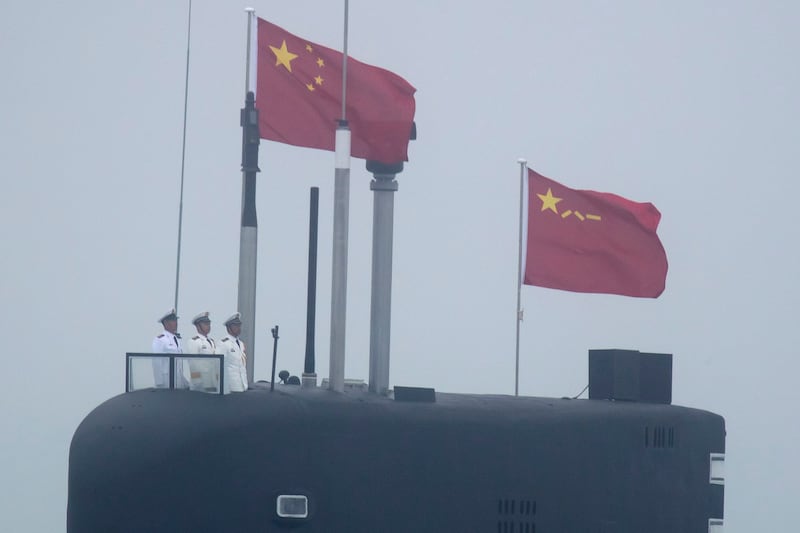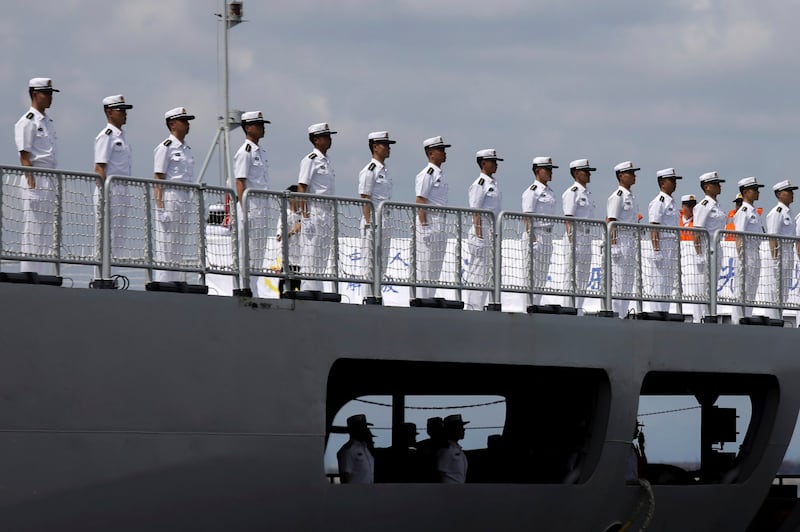Submarine experts and observers are casting doubt on reports by British media, citing leaked intelligence, that a Chinese nuclear submarine had an accident in late August, resulting in the deaths of 55 sailors.
The tabloid Daily Mail reported last Tuesday that the Chinese People's Liberation Army (PLA) Navy submarine '093-417' "apparently got caught in a trap intended to ensnare British sub-surface vessels in the Yellow Sea."
The incident is understood to have happened on Aug. 21. '093-417' indicates a Chinese Navy Type 093, or Shang-class, nuclear-powered attack submarine with hull number 417.
The Shang-class submarine is typically 107-meters long, 11-meters wide, and 7.5-meters high. It has a submerged displacement of more than 6,000 tons, and can accommodate a crew of 100. China currently has six of them in its submarine force.
“According to a secret UK report the seamen died following a catastrophic failure of the submarine's oxygen systems which poisoned the crew,” the Mail said.
The Times picked the story up a day later, saying that the Chinese vessel "was said to have run out of oxygen near Shandong province, north of Shanghai."
“Our understanding is death caused by hypoxia (lack of oxygen) due to a system fault on the submarine,” both papers quoted the leaked report as saying.
“The submarine hit a chain and anchor obstacle used by the Chinese navy to trap US and allied submarines. This resulted in systems failures that took six hours to repair and surface the vessel. The on-board oxygen system poisoned the crew after a catastrophic failure.”
It is unclear whether both the Daily Mail and the Times saw the same report, believed to be “held in high classification” but leaked to the media. The British Defence Ministry declined to comment on the reports.
The 55 crew members who are feared dead included 22 officers, seven officer cadets, nine petty officers and 17 sailors. The captain – Col. Xue Yong-Peng – is believed to be among the dead.

The media reports left submarine experts and military observers perplexed.
“I’ve never heard of submarine nets being used on the high seas, and I don’t understand why snagging one would cause a failure of atmosphere control equipment,” said Thomas Shugart, a retired submariner and adjunct senior fellow at the think tank Center for a New American Security in Washington D.C.
“However, China has had atmosphere control problems on its submarines before, so maybe there is something there but the details are off,” he added.
“Six hours is not enough to result in hypoxia without something else consuming the oxygen first, like a fire or explosion,” Shugart told Radio Free Asia.
Torpedo explosion
Two days after the Daily Mail's report, a Chinese-language media outlet based in Taiwan – UP Media – quoted anonymous sources in Beijing as saying that the real cause of the accident was "serious problems" of the Yu-3C torpedoes on the submarine.
The submarine was on a mission from Aug. 19 to 27 to conduct “underwater weapons tests" near Dalian Port in the Liaodong Peninsula, Liaoning province, UP Media said.
“However, not long after the mission began, a torpedo exploded in the launch tube,” it said, causing the crash that killed “all the people on board.”
The media outlet said an investigation was launched after the Central Military Commission determined that “the accident was directly caused by serious problems in the fire control design of the Yu-3C improved torpedo.”
Investigators are looking into allegations of “procurement fraud and corruption” involving not only officials in the submarine force but also at much higher levels, it said.
Defense Minister Li Shangfu, who has been missing from public view since late August, and Vice Admiral Wang Dazhong, commander of the PLAN North Sea Fleet, are believed to be involved, according to Shen Ming-Shih, Acting Deputy Chief Executive Officer at the Institute for National Defense and Security Research (INDSR) in Taiwan.
Shen said he understood from his sources that “Wang was sacked over the August submarine incident as it happened in the area within his command.”
“Li meanwhile is being investigated for responsibilities in the armament procurement, including for the submarine force, and personal graft,” he said.
‘Wait and see’
Some other experts remain more cautious.
“I'm taking a wait-and-see approach as several of the articles have now provided data that should be able to be verified,” Chris Carlson, a retired submariner and U.S. naval intelligence analyst, told RFA.
“Is Col. Xue Yong-Peng the commanding officer of Type 093A hull 417? Is that the right hull number for a Type 093A? Is he dead? Did the Northern Theater Commander, Vice Admiral Wang Dazhong get relieved for cause?”
“If these claims are found to be truthful, that would be sufficient evidence to say an accident on a PLAN Type 093A submarine occurred,” Carlson said.

Rumors of the alleged accident first emerged on Aug. 21 on an anti-Chinese Communist Party activist social media account called Lude Media. Its original post on the social media platform X, formerly known as Twitter, said "a Type 093 nuclear-powered attack submarine of the Communist Party of China had an accident while performing a mission in the Taiwan Strait."
Lude Media is a YouTube channel broadcast from the United States run by activist Wang Dinggang, who has in the past been accused of spreading unsubstantiated right-wing messages.
“The problem is the vast majority of the reporting [on the alleged incident] is from Taiwanese sources that have some credibility issues,” said Chris Carlson.
“It would be really helpful to get an official announcement,” he said.
Taiwan's Ministry of National Defense said on Aug. 22 that military intelligence and surveillance "did not detect any evidence of a Chinese submarine crash" in or near the Taiwan Strait.
The Chinese Defense Ministry on Aug. 31 also rejected the reports, which it called "completely false." The ministry has so far not reacted to the claims in the British media nor acted to prove them wrong.
“China can easily show this submarine to the world and stop the speculations,” said Shen Ming-Shih from INDSR in Taipei.
“Why don’t they do that?”
In April 2003, a Chinese Ming-class diesel submarine experienced a mechanical failure during a training exercise in the Yellow Sea, resulting in the deaths of all 70 crew members aboard.
Chinese state media did not cover the incident, believed to be the country’s worst known peacetime military disaster, until the following month.
Edited by Mike Firn and Elaine Chan.
